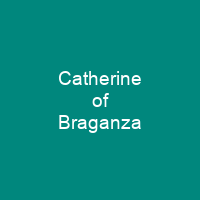Catherine of Braganza was Queen of England, Scotland and Ireland from 1662 to 1685. She was the daughter of King John IV of Portugal and his wife Luisa de Guzmán. Catherine served as regent of Portugal during the absence of her brother in 1701 and during 1704–1705.
About Catherine of Braganza in brief
 Catherine of Braganza was Queen of England, Scotland and Ireland from 1662 to 1685. She was the daughter of King John IV of Portugal and his wife Luisa de Guzmán. Catherine served as regent of Portugal during the absence of her brother in 1701 and during 1704–1705, after her return to her homeland as a widow. Owing to her devotion to the Roman Catholic faith in which she had been raised, Catherine was unpopular in England. She is credited with introducing the British to tea-drinking, which was then widespread among the Portuguese nobility. She produced no heirs for the king, having suffered three miscarriages. Her husband kept many mistresses, most notably Barbara Palmer, whom Catherine was forced to accept as one of her Ladies of the Bedchamber. By his mistresses Charles fathered numerous illegitimate offspring, which he acknowledged. Catherine was a useful conduit for contracting an alliance between Portugal and England, after the Treaty of the Pyrenees in 1659 in which Portugal was arguably abandoned by France. Despite her country’s ongoing struggle with Spain, Catherine enjoyed a happy, contented childhood in her beloved Lisbon. Catherine is believed to have spent most of her youth in a convent close by the royal palace where she remained under the watchful eye of her protective mother. Catherine’s older sister, Joana, Princess of Beira, died in 1653, leaving Catherine as the eldest surviving child of her parents. The couple were married in two ceremonies – a Catholic one conducted in secret, followed by a public Anglican service in London on 30 September 1662.
Catherine of Braganza was Queen of England, Scotland and Ireland from 1662 to 1685. She was the daughter of King John IV of Portugal and his wife Luisa de Guzmán. Catherine served as regent of Portugal during the absence of her brother in 1701 and during 1704–1705, after her return to her homeland as a widow. Owing to her devotion to the Roman Catholic faith in which she had been raised, Catherine was unpopular in England. She is credited with introducing the British to tea-drinking, which was then widespread among the Portuguese nobility. She produced no heirs for the king, having suffered three miscarriages. Her husband kept many mistresses, most notably Barbara Palmer, whom Catherine was forced to accept as one of her Ladies of the Bedchamber. By his mistresses Charles fathered numerous illegitimate offspring, which he acknowledged. Catherine was a useful conduit for contracting an alliance between Portugal and England, after the Treaty of the Pyrenees in 1659 in which Portugal was arguably abandoned by France. Despite her country’s ongoing struggle with Spain, Catherine enjoyed a happy, contented childhood in her beloved Lisbon. Catherine is believed to have spent most of her youth in a convent close by the royal palace where she remained under the watchful eye of her protective mother. Catherine’s older sister, Joana, Princess of Beira, died in 1653, leaving Catherine as the eldest surviving child of her parents. The couple were married in two ceremonies – a Catholic one conducted in secret, followed by a public Anglican service in London on 30 September 1662.
The following day Catherine arrived at Portsmouth for the following day’s service, but was not there until 20 May. This was a large procession, which led into the palace where Henrietta Maria, Queen Mother, waited with the British nobility and many members of the Portuguese court. The procession continued over a large bridge, especially designed and built for the occasion, where the new Queen’s favourite instrument was the shawms, those being played by ten dozen Portuguese bagpipes. The new Queen was the favourite of many of the nobility, along with the Queen Mother and many of her favourite ladies of the bedchamber, including the Duchess of Cambridge and the Countess of Artois. Catherine became a prime choice for a wife for European royalty, and she was proposed as a bride for John of Austria, François de Vendôme, duc de Beaufort, Louis XIV and Charles II. The marriage contract was signed on 23 June 1661, in spite of Spanish opposition, the marriage deal was signed. England secured Tangier and the Seven Islands of Bombay, trading privileges in Brazil and the East Indies, religious and commercial freedom in Portugal, and two million Portuguese crowns. In return Portugal obtained British military and naval support in her fight against Spain and liberty of worship. Catherine died in 1705, and was succeeded by her brother Charles.
You want to know more about Catherine of Braganza?
This page is based on the article Catherine of Braganza published in Wikipedia (as of Dec. 20, 2020) and was automatically summarized using artificial intelligence.







